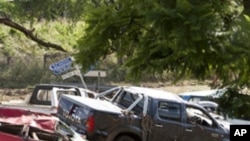Australia's Federal Treasurer Wayne Swan says the floods that have devastated huge areas of the country will inflict significant damage to the economy, and that rebuilding will take many years.
Swan said Monday the scale of this natural disaster could prove to be the costliest in the Australia's economic history. He said that in order to bring the budget to a planned surplus by 2013, the government will have to make some tough decisions, including spending cuts.
Swan also acknowledged that the extent of the damage could have an effect on the future of the insurance industry.
Floods have affected three-quarters of Queensland state, where they submerged more than 40 communities and caused billions of dollars in damage from destroyed homes and crops, broken infrastructure and lost commodity exports.
After receding in Queensland, floods hit the state of Victoria, where they swamped more than 1,400 homes in 43 towns.
Weeks of flooding in the northeastern state of Queensland have caused nearly 30 deaths, at least 17 just this month. The state capital, Brisbane, was hit by a devastating flash flood on January 10. Officials say 14 people are still missing.
In the capital alone, floods completely destroyed close to 20,000 homes and partially flooded at least another 15,000. A huge clean-up effort is underway.
In the state of Victoria, the area that was devastated by deadly wildfires two years ago is now facing what could be its worst flooding in 100 years. Thousands of people have fled.
Experts have linked Australia's downpours to a weather pattern called La Nina, which has brought in cooler temperatures that have strengthened the normal tropical cyclone season.
Australian Treasurer: Floods Will Damage Economy







